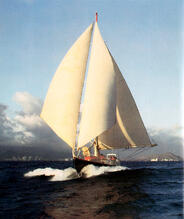
Big adventure on the high seas has come in many forms throughout history. For Bob and Nancy Griffith, it had been a way of life that put them in the record books and made them part of modern seafaring legend.
Starting in 1959, Dr. Robert Lyle Griffith started a series of round-the-world voyages with his wife Nancy and son Reid. The first circumnavigation was aboard the
Awahnee I, which was latter lost on a reef near the Tuamotu Islands, the largest of the Tahiti-Polynesian archipelagoes, while on a rescue mission for an American yacht. That first voyage was east to west around the Horn and Cape of Good Hope.
The family's second circumnavigation was aboard their self-built, ferro-cement cutter the
Awahnee II and was east bound via Japan. The third trip was also aboard that vessel
, and was a southernly route around Antarctica from New Zealand with stops at the
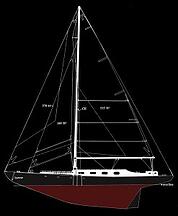
American, English, Russian, Chilean and Argentine scientific outpost stations. They roughly followed the course of Captain James Cook, the first to circumnavigate the Antarctic. During the voyage, Captain Cook's 205-year-old journal was kept aboard and read aloud by Nancy as they followed his track. The circumnavigation had taken 111 days (the fastest on record and following a route never before attempted by a pleasure craft), 84 of which were sailing days and 27 of which were in port or partial sailing days.
As one might imagine, the Griffith's have a treasure-trove of wild stories and perilous tales from their many adventures on the high seas. From shipwrecks to being thrown overboard into shark-infested waters, they survived and thrived under challenges and odysseys most of us only read about. Fortunately, the Griffith's were not only expert sailors but photographers that captured the images of their voyages on high-quality Kodachrome slide film.
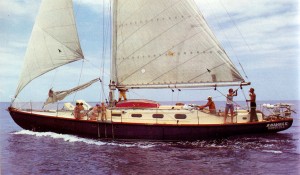
"We were delighted to be awarded the project to digitally convert and preserve this large, highly-valued collection of photos from the Griffith family archives" said Julie Morris, President of
FotoBridge, a New Jersey-based
photo scanning service . FotoBridge digitized thousands upon thousands of spectacular images from 35mm slides dating back the the 1950s. "The resulting images were fantastic, due largely to the excellent exposures, the archival qualities of the films used and the FotoBridge digital capture processes and systems", added Ms. Morris.

In 1972, Bob Griffith was awarded the prestigious
Blue Water Medal by the Cruising Club of America. In bestowing the award, the late John Parkinson, commented, "In all my years of serving on this committee, in my opinion we have never had a recipient so deserving of this honor". After nearly 200,000 miles under sail, Bob and Nancy Griffith wrote and published
Blue Water: A Guide to Self-Reliant Sailboat Cruising NOTE: Images and information source,
Blue Water via
insidemystery.org FotoBridge, the national photo scanning service picked by New York Magazine as "Best Photo Digitizer", recently completed a significant photo scanning engagement to digitize NBCUniversal's corporate photographic archives.
FotoBridge, the national photo scanning service picked by New York Magazine as "Best Photo Digitizer", recently completed a significant photo scanning engagement to digitize NBCUniversal's corporate photographic archives. Based at Rockefeller Center, in mid-town Manhattan, NBCUniversal is a collection of some of today's most valuable media assets owned by Comcast and General Electric (51% and 49% respectively). The company traces its' history back to predecessor companies Vivendi Universal and MCA Inc. Formed in 2004 through the merger of GE's NBC with Vivendi's Universal Entertainment and subsequent buyout by Comcast in 2009. Today, the NBCUniversal family of brands include NBC, Universal Pictures, NBCUniversal Television Group, NBC News, CNBC, MSNBC, Bravo, The Weather Channel and Hulu.
Based at Rockefeller Center, in mid-town Manhattan, NBCUniversal is a collection of some of today's most valuable media assets owned by Comcast and General Electric (51% and 49% respectively). The company traces its' history back to predecessor companies Vivendi Universal and MCA Inc. Formed in 2004 through the merger of GE's NBC with Vivendi's Universal Entertainment and subsequent buyout by Comcast in 2009. Today, the NBCUniversal family of brands include NBC, Universal Pictures, NBCUniversal Television Group, NBC News, CNBC, MSNBC, Bravo, The Weather Channel and Hulu.










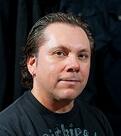


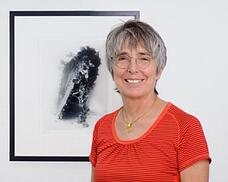

 From it's base in Washington D.C. and offices in Brussels, Belgium - the
From it's base in Washington D.C. and offices in Brussels, Belgium - the 
 General aviation includes all aviation with the exception of military and commercial airlines. It plays an important role in economic growth and represents one of the most important and dynamic industries on the globe. In 2006, general aviation contributed over $150B and $53B to the US economy in output and wages (respectively, including direct, indirect and induced). General aviation also supported 1.2M jobs during the same period.
General aviation includes all aviation with the exception of military and commercial airlines. It plays an important role in economic growth and represents one of the most important and dynamic industries on the globe. In 2006, general aviation contributed over $150B and $53B to the US economy in output and wages (respectively, including direct, indirect and induced). General aviation also supported 1.2M jobs during the same period. Legions of
Legions of  "Color me impressed.
"Color me impressed.  To say NJ businessman
To say NJ businessman  and Richie Sambora. But despite it’s early success, in 1992 the company filed for bankruptcy. A company owned by the Jackson family agreed to purchase the guitar company from Henry Vaccaro, but soon defaulted on the payments. Thus began the decades-long series of legal battles that ultimately resulted in the legal transfer of priceless Michael Jackson and Jackson Family items to Henry Vaccaro. The collection is reported to include over 60 unreleased master tapes, costumes, letters, documents and gold records. It also includes thousands of never before publically seen photographs captured on Kodachrome slide film. The photos include professionally shot Jackson 5 concert performances and other images spanning years of Jackson family history.
and Richie Sambora. But despite it’s early success, in 1992 the company filed for bankruptcy. A company owned by the Jackson family agreed to purchase the guitar company from Henry Vaccaro, but soon defaulted on the payments. Thus began the decades-long series of legal battles that ultimately resulted in the legal transfer of priceless Michael Jackson and Jackson Family items to Henry Vaccaro. The collection is reported to include over 60 unreleased master tapes, costumes, letters, documents and gold records. It also includes thousands of never before publically seen photographs captured on Kodachrome slide film. The photos include professionally shot Jackson 5 concert performances and other images spanning years of Jackson family history.